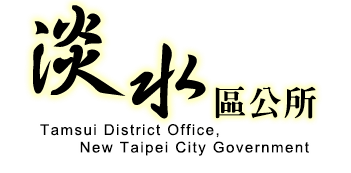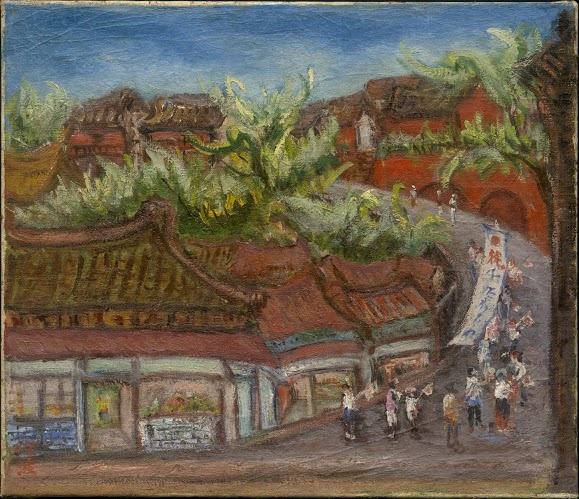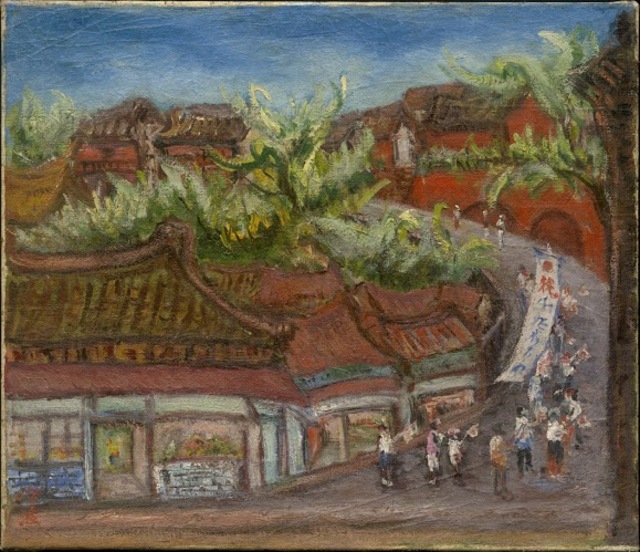畫作名稱
雨後淡水 約1937-1945年 畫布油彩 45.5×53cm 私人收藏
Tamsui After Rain Date Unknown Oil on canvas 45.5x53 cm Private collection
雨後の淡水 約1937-1945年 キャンバス油彩 45.5×53㎝ 個人蔵
畫作解析
太平洋上的戰雲密布,雨後的淡水似乎也籠上了一層戰爭的陰霾。出征旗上大紅色的「祝」字雖然醒目,但寥落的人群隊列裡,似乎沒有一樣的歡悅氣氛。沿著九崁街婉轉上行,就是淡水的古老街區,那樣懷舊的地方,也許適合一場告別家鄉的遊行吧。目送著人群隊伍的離去,陳澄波默然勾勒著時代的陰影,為歷史留下了他的見證。
Under the dense cloud cover of the Pacific Ocean war, Tamsui after rain seems to be enveloped in a layer of haze from the warfare. Although the big red character “Blessing (祝)” on the banner set off on a campaign is eye-catching, the sparse number of people in the formation seems to lack the same joyful atmosphere. The entourage following Jiukan Street turning up is in Tamsui’s old neighborhood; this kind of nostalgic place is perhaps more suitable for a parade bidding adieu to one’s hometown. Watching the procession of people leave, Chen Cheng-po silently outlines the shadow of the times and leaves his witness to history.
太平洋上の戦雲は深く、雨後の淡水にも戦争の暗さがおおいかぶさっているようである。出征旗の「祝」の文字はあざやかであるが、集まった人々は寂しげで祝賀の雰囲気は感じられない。九崁街を上がったあたりは淡水の古い町並みであるが、故郷との別れの儀式にはふさわしい場所なのかもしれない。人々の列が去っていくのを見送りながら、陳澄波は黙々と時代の陰影をふちどり、歴史の証言者となっている。
- 壯行會
二戰時候,受國家徵召或志願入伍的軍人,在遠赴戰場之前,地方政府時常動員群眾、學生與各機關團體,為他們舉辦一場熱鬧的「壯行會」。畫中的遊行隊伍人人手執國旗,他們正要走進九崁街裡,宣揚戰士的光榮出征。
- Fare-well Party
During WWII men were either conscripted or volunteered to join the military, but before going to the battlefield the local government usually mobilized the public, students and various organs and groups to hold a boisterous fare-well party for them. In the painting all the people in the procession are holding the national flag in their hands; they are just about to proceed into Jiukan Street to publicize the glory of the soldiers going to war.
- 壮行会
第二次世界大戦期、召集あるいは志願により入隊した軍人が遠く戦場へおもむく際、地方の行政単位は、住民や学生、各種団体を動員して「壮行会」をもよおした。作品中の行列の人々は国旗を手に九崁街を歩き、名誉の出征をする戦士を送っている
筆記備查:
http://blog.xuite.net/anti8h8h/marathon/209522340-%E6%96%B0%E7%AB%B9%E5%B7%9E%E8%BB
%8D%E5%A4%AB%E5%A3%AF%E8%A1%8C%E6%9C%83
http://the.nmth.gov.tw/Cht/LocList.aspx?catalog=F.6
Note reference:
http://blog.xuite.net/anti8h8h/marathon/209522340-%E6%96%B0%E7%AB%B9%E5%B7%9E%E8%BB
%8D%E5%A4%AB%E5%A3%AF%E8%A1%8C%E6%9C%83
http://the.nmth.gov.tw/Cht/LocList.aspx?catalog=F.6
- 出征旗
為了把出征塑造為榮耀之事,送行儀式裡常會樹起這樣的大旗,旗上繪有日本國旗的「日之丸」,或代表日軍的旭日紋樣,並以大字書寫出征者的名字。豎起出征旗,除了祝願士兵的武運昌隆,其實也是一種戰爭動員的宣傳手段。
- Banner set off on a campaign
In order to make going on campaign a glorious affair, the ceremony of bidding adieu often set up this kind of big banner; the banner had the Japanese national flag, Hinomaru (The Sun), or the pattern of the rising sun representing the Japanese military painted on it along with the name of the one going on campaign written on it. Holding the banner up high besides wishing the soldier martial glory, also was actually a kind of propaganda move for wartime mobilization.
- 出征旗
出征を名誉なものとして印象づけるべく、儀式の際にはこの絵にあるような大きな旗を立てた。旗には日本の国旗の日の丸、もしくは日本軍のシンボルである旭日模様がえがかれ、出征者の名前が大書きされていた。かかげられた出征旗は、兵士の武運昌隆を願うものであるとともに、人々を戦争へかりたてるための手段でもあった。
筆記備查:http://blog.xuite.net/anti8h8h/marathon/209206057
Note reference:http://blog.xuite.net/anti8h8h/marathon/209206057
- 九崁街
福佑宮後方的九崁街是形成於18世紀末的商業街肆。由於河岸空間較為狹窄,陸續增加的淡水人口,沿著這條街道向山坡上的「崎仔頂」延伸居住空間,發展聚落的規模。
- Jiukan Street
Jiukan Street in back of Fuyou Temple was a street of commercial shops formed at the end of the 18th century. Since the space on the river bank was relatively narrow and the Tamsui population continued to increase, this street followed up the slope to Qizaiding to extend the residential space and develop the scale of the town.
- 九崁街
福佑宮後方の九崁街は18世紀末に形成された商店街である。河岸はスペースが限られているため、淡水の人口が増加するにつれて九崁街から坂の上の崎仔頂へと居住空間が伸びていき、集落の規模を拡大させていった。
- 磚拱
順應淡水山坡的地形變化,九崁街上的一戶民家,以磚拱築成樓梯的基底,連接上方建物的出入口。兩個醒目的磚拱,至今仍存在於九崁街上。方向雖然與這幅畫的描繪不同,但樣式大抵是一致的。
- Brick Arch
In order to accommodate the topographical changes of Tamsui’s hillsides, one house of Jiukan Street used brick arch construction to make the foundation of a platform connecting to the entrance of the building above. Two eye-catching brick arches still exist today on Jiukan Street. Although the direction depicted in this painting is not the same, the style is more or less the same.
- レンガアーチ
九崁街のある民家は、丘の多い淡水の地形に合わせてレンガアーチを階段の基礎とし、上部の建物の出入り口につなげている。絵の中でよく目立つ二つのアーチは今日でも九崁街に残っている。絵と実際とでは方向は違うが、様式はおおよそ一致する。
- 福佑宮
正脊兩端向上翹起的「燕尾」,經常使用於臺灣的寺廟建築當中。若參照九崁街的相對位置,可推測該建物應是淡水河畔的福佑宮。主祀媽祖的福佑宮始建於1782年,是早期來到淡水的福建與粵東移民共同的信仰中心。
- Fuyou Temple
The “swallowtails” that stick up at either end of the roof ridge are commonly used in the construction of temples in Taiwan. If you consult the relative position of Jiukan Street, you can conjecture that the building is the Fuyou Temple along the riverbank in Tamsui. Fuyou Temple devoted mainly to the worship of Mazu was constructed in 1782. The temple was the common site of worship for the early immigrants coming to Tamsui from Fujian and Guangdong.
- 福佑宮
棟の両端が反りあがった燕尾は台湾の寺廟建築によく見られるものである。九崁街との位置関係から判断すれば、この建物は淡水河畔の福佑宮であろう。媽祖をまつる福佑宮は1782年に建立されたもので、早期に福建や広東東部から淡水にやってきた移民の信仰の中心だった。
- 店屋
淡水街上的店屋,通常有窄長的格局。面對大街的店面以屋頂上的閣樓為倉庫,後方則與店主的住家相連。臺灣許多港口附近的聚落,例如鹿港、安平等地,皆有這類長型的店屋。
- Shops
The shops along Tamsui’s streets usually had a long narrow layout. The shop facing the main street used the rooftop attic as a warehouse and the rear area was connected with the shopkeeper’s family. The towns near many of the harbors in Taiwan, such as Lugang, Anping, etc. all had this kind of long-style of shops.
- 店舗
淡水の街中の店舗は細長い作りになっているものが多い。店が通りに面し、屋根裏が倉庫、後ろが店主の住居となっている。鹿港や安平といった台湾の港町の集落では、こうした形の店舗がよく見られる。
陳澄波1933年的畫作〈鹿港老街〉,兩旁的店屋也屬於同樣窄長、多進的長屋格局。
Chen Cheng-po’s 1933 painting “Old Market Street in Lugang” . The shops on both sides all have the same long narrow style with a long room layout.
陳澄波「鹿港老街」(1933年)。両側にはやはり細長い作りの建物が並んでいる。
日文翻譯:富田哲
英文翻譯:Darrel Doty




